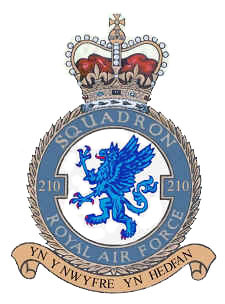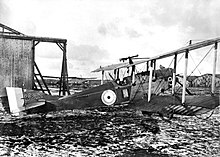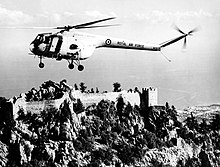No. 149 Squadron RAF was a Royal Air Force Squadron between 1918 and 1956. Formed 1918 in the Royal Flying Corps as a night-bomber unit, it remained in that role for the rest of its existence which spanned three periods between 1918 and 1956.

No. 138 Squadron RAF was a squadron of the Royal Air Force that served in a variety of roles during its career, last disbanded in 1962. It was the first 'V-bomber' squadron of the RAF, flying the Vickers Valiant between 1955 and 1962.
No. 635 Squadron RAF was a heavy bomber squadron of the Royal Air Force during the Second World War.
No. 622 Squadron RAF is a reserve aircrew squadron of the Royal Auxiliary Air Force. During World War II, it operated as a bomber squadron of the Royal Air Force. Post-war it served shortly as a transport squadron in the RAuxAF.
No. 692 Squadron RAF was a light bomber squadron of the Royal Air Force during the Second World War.

No. 607 Squadron is an auxiliary squadron of the Royal Air Force. It was formed in 1930 as a bomber unit in the Auxiliary Air Force and changed in 1936 to the fighter role. It fought in that role during the Second World War in Europe and Asia. After the war, in 1946, the squadron reformed as a fighter unit. Awarded the title Royal Auxiliary Air Force by King George in 1947, 607 Sqn was disbanded with all the other flying units of the RAuxAF on 10 March 1957. It reformed on 5 January 2015, as a General Service Support Squadron (GSS).
No. 625 Squadron RAF was a heavy bomber squadron of the Royal Air Force during the Second World War.
No. 513 Squadron RAF was a non-operational bomber squadron of the Royal Air Force in 1943.
No. 160 Squadron RAF was a Royal Air Force unit during the Second World War, when it flew for four years in a number of roles including heavy bomber, minelaying, reconnaissance, special operations and transport unit in the Middle East and South-East Asian theatre of World War II.

No. 210 Squadron was a Royal Air Force unit established in World War I. Disbanded and reformed a number of times in the ensuing years, it operated as a fighter squadron during World War I and as a maritime patrol squadron during the Spanish Civil War, World War II and the Cold War before it was last deactivated in 1971.
No. 158 Squadron RAF was a World War I proposed ground attack squadron that did not become operational in time to see action, and a World War II bomber squadron. After World War II had ended in Europe the squadron operated in the transport role until disbandment in December 1945.

No 605 Squadron was formed as an Auxiliary Air Force Squadron. Initially formed as a bomber unit, it was one of the most successful participants of the Battle of Britain. It also had the distinction of being active during the Second World War at two fronts at a time, when the squadron was split up between Malta and the Dutch East Indies. In its last incarnation as an active flying unit, the squadron served as the first jet fighter unit in the post-war Royal Auxiliary Air Force; 616 having already flown Gloster Meteors during the war. No. 605 Squadron was reformed as a RAuxAF Logistic Support Squadron (LSS) on 1 Nov 2014 within No. 85 Expeditionary Logistics Wing of the RAF A4 Force. On the 1 January 2019, the Reserve Logistic Support Wing (RLSW) was established with 501, 504 and 605 LSS Squadron's moving from No. 85 Wing RAF to form RLSW.
No. 502 (Ulster) Squadron was a Royal Auxiliary Air Force squadron that saw service in World War II. It was reformed in September 2013, and is the oldest of all the reserve squadrons, being formed in 1925.
No. 608 Squadron was an Auxiliary Air Force squadron of the Royal Air Force during the Second World War. It flew during its existence as a bomber, fighter and reconnaissance unit and was the only RAF squadron to be equipped with the unsuccessful Blackburn Botha torpedo bomber.
No. 503 Squadron RAuxAF was an auxiliary squadron of the Royal Air Force. It operated as a bomber squadron in the 1920s and 1930s, but was disbanded before the outbreak of the Second World War.

No. 103 Squadron was a Royal Air Force bomber squadron during World War I, World War II and the Cold War, switching to helicopters in the late 1950s until it was disbanded for the last time in 1975.

No. 627 Squadron was a Royal Air Force Mosquito aircraft pathfinder bomber squadron that operated during the Second World War.

No. 614 Squadron was originally formed on 1 June 1937 as an army co-operation squadron unit of the Auxiliary Air Force. It served during the Second World War first in this role and later as a bomber squadron. Upon reformation it served as a fighter squadron until the disbandment of the Royal Auxiliary Air Force on 10 March 1957.
No. 137 Squadron RAF existed briefly as a day bomber unit in World War I but never became operational. During World War II it flew as one of the two Whirlwind squadrons before converting to Hurricane Mk.IV fighter-bombers and later the Hawker Typhoon in the same role. The squadron was disbanded in August 1945.

No. 156 Squadron RAF was a Royal Air Force Squadron that was active as a bomber unit in World War II.












